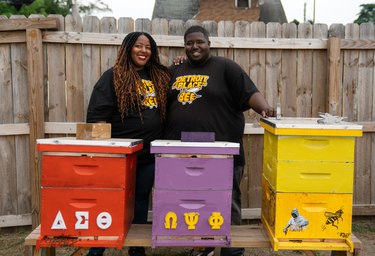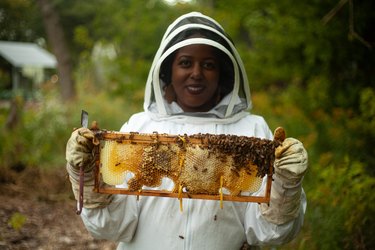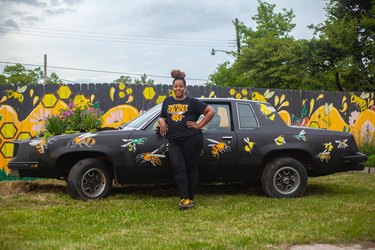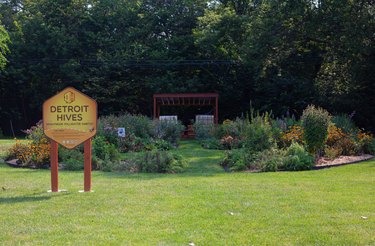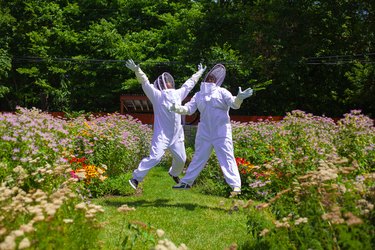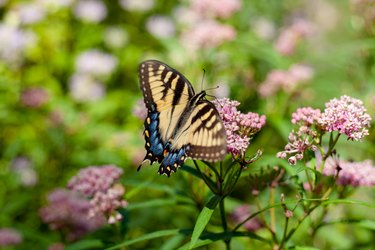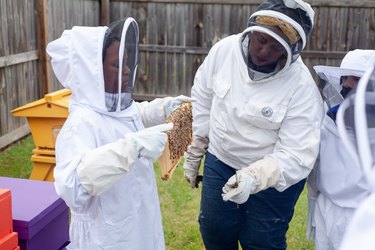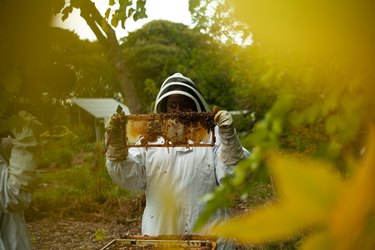Timothy Paule couldn't kick a cough for weeks—until he took a friend's advice and tried raw honey to soothe his throat. Thanks to the superfood's antibiotic properties, the cough disappeared, Timothy says. But that's not the only thing the unprocessed honey did. It also sparked an idea. It got Timothy, and his partner, Nicole Lindsey, both Detroit natives and community activists, thinking about honeybees. Specifically how the endangered insects could help Detroit's underserved neighborhoods fight blight, improve access to fresh food and play a pivotal role in pollinator conservation.
Video of the Day
Soon after Timothy's recovery, he and Nicole founded the nonprofit Detroit Hives, a network of bee farms and native plant gardens that the couple have installed in vacant lots and in urban food farms in some of Detroit's most disadvantaged neighborhoods. Timothy and Nicole, now certified beekeepers, care for more than 54 honeybee colonies in some 27 locations—ensuring the bees are healthy and pest-free; feeding bees during seasons when nectar and pollen are not available; harvesting honey; and keeping the queen and her young brood happy and safe.
Video of the Day
The nonprofit also gives tours of their sites, teaches schoolkids the importance of conserving endangered bees and raises awareness of urban beekeeping. (Timothy and Nicole even started a holiday, National Urban Beekeeping Day, on July 19.) And did we mention they also sell raw honey? "We love our city and wanted to give back, as well as teach people the importance of saving bees," says Timothy, who also owns a marketing and photography business. "So we found a way to create social, environmental and cultural impact in our city."
They certainly did! Their outreach projects stand out for their sheer creativity: In 2021, they created the Motor City Garden, a pollinator garden built in an upcycled 1981 Oldsmobile Cutlass. And they recently bought the land where rapper Eminem's childhood home once stood, a well-known site featured in one of his albums. It's now being transformed into a pollinator habitat. Timothy and Nicole hope to expand the project to include a large-scale apiary and additional lots with features such as an electrical charging station for cars.
We spoke to the couple to discuss everything bees, what makes city bees special and how to move them...(very, very carefully).
Let’s set the scene: Detroit has been economically challenged for decades, which caused a lot of people to move out, leaving abandoned property and land lots, correct?
TIMOTHY: The city has well over 9,000 vacant lots that have been left unattended for years, if not decades, mostly in underserved communities. They are vulnerable to crime and blight and are not safe for children because of broken glass and a lot of illegal activity. So a few years ago, the city put out a call to action to residents and community organizations to purchase and put these vacant lots to use for a reduced price. Most residents didn't want anything to do with them because it's a lot of maintenance and extra expense. When Nicole and I heard, we wanted to come up with a way to strengthen our community by buying and repurposing the lots.
Why did you think urban beekeeping would help?
TIMOTHY: Residents who live around these abandoned lots want a safe, calm, clean, beautified space. They're also surrounded by gas stations, liquor stores and restaurants where a lot of the juices, salad dressings, desserts and candy are loaded with aspartame, high-fructose corn syrup and other sweeteners detrimental to health. Raw, local, unprocessed honey is a natural sweetener that doesn't spike blood sugar, and we wanted to make it accessible to residents. We also wanted to find a way to help provide food security.
How does having bees in these neighborhoods do that?
TIMOTHY: Part of what we do is partner with farmers by introducing hives in their urban gardens. When bees and other pollinators visit your basil, thyme and many other flowering crops and fruit trees, you're guaranteed to see an increase in crop yield.
That gets to the heart of why bees are such an important part of the ecosystem.
NICOLE: Yes. Bees are responsible for a third of the food we eat because they pollinate crops. The entire produce section, as well as food sources for animals and pollinators, would disappear if bees didn't exist. Everything is connected.
TIMOTHY: The number one problem is disappearing habitat and chemicals in pesticides. It hurts everyone. If we do away with trees and green spaces, which are so good for our mental health, it begins to have a negative effect on everyone.
How to Help Save the Bees
You don’t have to be a beekeeper to help the hardworking pollinators, say Timothy Paule and Nicole Lindsey. Here are a few ways to help in the fight to save bees.
1. Plant black-eyed Susans. The sunflower-like yellow wildflowers are easy to grow, and their sturdy black centers are easy for bees (and other pollinators) to spot and rest on.
2. Leave out a water source. Yes, bees drink water, and not just when thirsty. They also use it to cool the hive and dilute too-thick honey. Simply fill a shallow dish with water, but fill it with plenty of pebbles that bees can land on, because they can’t swim.
3. Don’t spray harmful chemicals on your lawn and garden. “They’re bad for people, pets and pollinators,” Timothy says.
4. Support your local urban beekeeper. Buy honey from them (bonus: as area bees feast on local pollen, their honey will help counter seasonal allergies!), volunteer at nonprofit bee farms or make a donation.
Is there something special about city bees in particular?
TIMOTHY: Yes! They often outperform rural bees health-wise and in terms of diversity because of the plant density and diversity in urban areas. A lot of rural areas have monocultural farming [one type of crop on fields, as opposed to many].
NICOLE: Detroit's vacant lots tend to have a lot of diversity of native flowers, and that boosts the native bee population, as well.
So much so that you’re often asked to relocate swarms of bees that pop up throughout the city on trees and houses. What’s the process?
NICOLE: We get a lot of calls from May to July, when hives become overpopulated. About half the bees and the queen leave to form a new hive. They hang together in a swarm while the scout bees search for a hive site, which could take weeks. We scoop up the thickest cluster of bees—because the queen is likely in there—then place it into a hive box, or even a shoebox. The rest follow the queen's scent and start flying into the box.
Lots of people are terrified of bees. But your Instagram is full of people, especially kids, getting close and even holding them in their palm. How do you ease fears?
NICOLE: Listen, when we first started working with bees, I was just as afraid as anyone else! Like most people, I was actually scared of yellow jackets, which are aggressive wasps often confused for bees. Then, when I started learning about bees, that fear transformed into a love that developed my passion to educate people about them. Once people see me working with a hive and understand that bee colonies are a super-organism where everyone works together for the greater good, they start asking more questions and become engaged.
Okay, then, let’s nerd out on bees. What are some fascinating facts?
TIMOTHY: Bees can see shape and color. That information would not have been discovered if not for Charles Henry Turner [an African American entomologist and zoologist]. He was the first scientist who discovered it. With this info, he inspired beekeepers worldwide to do extensive research on honeybees.
TIMOTHY: I prefer to replace terms like Brown and Black people—because those are just colors—with the term "indigenous." But yes. We've been farmers, herbalists, conservationists, beekeeping or "honey-hunting" for thousands of years. A lot of history gets lost, whitewashed or not carried on.
We had to do our homework and find other beekeepers that we identify with, other indigenous—or sometimes labeled Black—beekeepers, such as Turner, George Washington Carver, Benjamin Banneker. We had to dig and find stories, then post about their contributions. My own great-grandfather kept bees in Greenville, SC, and I only found out when we started working with bees by talking to my grandparents. It completely blew my mind.
Now that’s an awesome bee fact.
NICOLE: My favorite bee fact is that bees can recognize your voice, your face and your scent.
Wow! How do we know this? Like, do you have a bee buddy who always comes up to you to say, "What’s up?"
NICOLE: Ha ha, no! But there are studies on it.
TIMOTHY: Bees can see, smell and feel vibrations. So they can piece together your face with the 7,000-plus lenses in their eyes. They have very strong smell receptors to pick up your scent, and they can get used to your voice vibration. When they associate our face, voice and scent as nonthreatening, they get more comfortable.
How comfortable? Like, do you name them?
NICOLE: Oh, yes. We let the kids who visit one of our gardens on school trips name the queens. We have a Bee-yoncé, a Cardi Bee, and a Queen Eliza-bee. What can I say? We love what we do, and we're having a ball!
